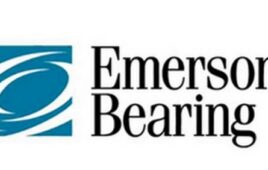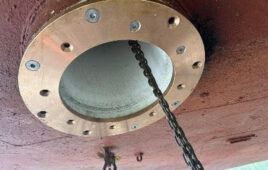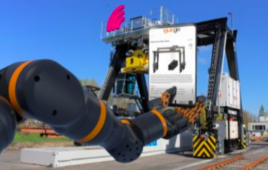By Mike Santora
Timken and Robbins are collaborating on the tunnel boring machine set to carve a path for the Ohio Canal Interceptor Tunnel in Akron, OH. In this first installment of a two part story, we interviewed the principle engineers on the project to learn about some the challenges bearings can face in such a demanding application.
The city of Akron, OH has never seen a construction project quite like the Ohio Canal Interceptor Tunnel (OCIT). 6,240-ft. of heartland lies between the Little Cuyahoga River on the Ohio & Erie Canal Towpath and Lock 1 of the canal at West Exchange Street in the city’s downtown area. To connect the two locations, a tunnel boring machine (TBM) is set to do the hard work of clearing the underground path for construction. With the clearing of shale, soft rock, hard rock and the occasional boulder, a TBM relies heavily on bearings working in harsh conditions. Robbins called on Timken to provide many of the bearings on this project’s TBM, continuing the two companies’ 60+ year relationship.
 Robbins tries to standardize its TBM’s as much as possible but the OCIT project has some unique challenges. The situation requires a specific digging strategy and some machine specialization.
Robbins tries to standardize its TBM’s as much as possible but the OCIT project has some unique challenges. The situation requires a specific digging strategy and some machine specialization.
“We’re going to start on soft ground with fairly low cover over the tunnel, so the machine will operate in what we call closed mode, it will be essentially like a submarine. We will keep pressure at the excavation face and the bulk head of the machine will be the barrier. Inside the machine is an atmospheric pressure and at the cutting face it’s pressurized to whatever pressure we need to counteract the ground pressure, hydrostatic pressure or ground water. We estimate this figure to be a maximum of about 3 bar pressure.,” said Robbins’ Chief Engineer Dennis Ofiara.
However, Ofiara also explained that once the machine gets into shale, and the cover over the tunnel increases, the sturdier rock allows them to operate in open mode. In this scenario, the bulk head of the machine acts as a gate that when opened allows engineers to move the material as fast as they can cut it.
Overall, the project is a balance between the machine operating in open and closed mode, having both capabilities without making the machine too complicated. Usually in open mode the excavated material is removed with a belt conveyor, in closed mode, it’s removed with a screw conveyor. It is a big job to interchange belts on a screw conveyor. For the OCIT project the plan is to change modes a couple times along the line of the tunnel because the depth of the cover varies. The bearings needed to handle this job are fairly standard in the industry. They have been refined for years to handle the specifics of TBM applications like this.
“For this application we’re using heavy sectioned bearings. They’re called an HH bearing, which stands for very heavy duty. There’s two different types, a 19-in. cutter and a 17-in. cutter bearing and these are pretty predominant in the industry. The geometry that we use on them has evolved to where it is now optimal for general tunnel boring The wall section on the bearing is quite thick and can carry a high load and has a high power density. Also, the geometry of the interfaces of the rollers on the races, and the roller end on the large rib of the inner race, is optimized to minimize degeneration. This is done while still providing full support to the roller end to accommodate the overturning moment that can be seen in this tunnel boring environment,” said Timken Principal Application Engineer Tim Murphy.
Generally speaking, on these cutters technicians will change the cutter ring as the ring on the outside of the bearing actually does the cutting into the tunnel face. It is common to see four to five rings changed before a bearing is changed out. Ultimately, changing the rings out is entirely dependent on the geology. The ground involved in the OCIT project is rather forgiving by industry standards. The ground is mostly soft. Yet the impact loads caused by a stray boulder can be a real problem. And, of course, contamination is always a concern.
“We’ll have some mixed space with soft ground and perhaps some boulders. That’s a more demanding part of the job because large boulders can have high impact forces, that can cause some bearing problems. The other challenge is to keep the bearings well sealed. In the closed mode, there’s pressure at the excavation face, the cutters themselves are actually subjected to pressure. We’ve got metal based seals and try to keep contaminates out, but sometimes the seals are breached and that can result in a bearing failure. Not the fault of the bearing of course, but something to watch for,” said Ofiara.
Further complicating things, in soft ground the cutters do not have much traction. Normally, when the cutters are pressed against a rock base, there is enough of a resistant force to cause them to turn as they should. In soft ground, that force may not be present. They won’t turn. They’ll skid. And even though the ground can be soft, it might be an abrasive substance like sand. These types of earth will wear the cutter flat and sometimes even wear through the hub of the cutter and into the bearing. Ofiara says, “All-in-all, 6,200 feet in that ground in Akron, we will not change the bearings. If we were in hard rock, the bearing life could be down to 100’s of hours and could range in the 1,000’s of hours.”
Timken
www.timken.com
Robbins
www.therobbinscompany.com
The post Part 1: Timken and Robbins team up for Ohio tunnel project appeared first on Bearing Tips.
Filed Under: Bearing Tips




